Mary MacKillop facts for kids
Quick facts for kids SaintMary MacKillop R.S.J. |
|
|---|---|
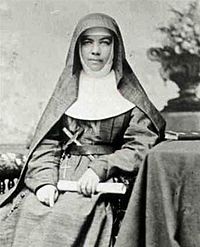
Mother Mary of the Cross (1869)
|
|
| Founder | |
| Born | 15 January 1842
|
| Died | 8 August 1909 (aged 67) North Sydney, New South Wales, Australia |
| Venerated in | Catholic Church |
| Beatified | 19 January 1995, Sydney, New South Wales by Pope John Paul II |
| Canonized | 17 October 2010, Vatican City by Pope Benedict XVI |
| Major shrine | Mary MacKillop Place, North Sydney, New South Wales, Australia |
| Feast | 8 August |
| Patronage |
|
Mary Helen MacKillop (15 January 1842 – 8 August 1909) was an Australian religious sister. She is known as Saint Mary of the Cross in the Catholic Church. Mary was born in Melbourne, Australia, to Scottish parents. She is famous for her work in South Australia.
Mary MacKillop and Julian Tenison-Woods started the Sisters of St Joseph of the Sacred Heart. This group of religious sisters opened many schools and help centers. They focused on educating poor children in country areas of Australia and New Zealand.
The Catholic Church began the process to declare Mary a saint in the 1920s. She was declared "blessed" (beatified) in 1995 by Pope John Paul II. In 2009, the Church recognized a second miracle linked to her prayers. She became a saint on 17 October 2010, at the Vatican. Mary MacKillop is the first Australian to be recognized as a saint by the Catholic Church. She is the patron saint of the Roman Catholic Archdiocese of Brisbane.
Contents
Mary MacKillop's Early Life
Mary Helen MacKillop was born on 15 January 1842. This was in an area of Melbourne now called Fitzroy, Victoria. Her parents were Alexander MacKillop and Flora MacDonald. Mary was baptized Maria Ellen, but everyone called her Mary.
Her parents came from Scotland. Mary visited their home village in the 1870s. The local Catholic church there now has a special shrine to her.
Mary's father, Alexander, studied to become a priest but left before he was ordained. He came to Australia in 1838. Her mother, Flora, arrived in Melbourne in 1840. They married in Melbourne in 1840. Mary was the oldest of their eight children. Her brother Donald became a priest and worked with Aboriginal people. Her sister Lexie became a nun.
Mary was taught by her father and at private schools. Her family often faced hard times. Her father struggled as a farmer and gold prospector. In 1851, he left the family for 17 months to visit Scotland.
At 16, Mary started working in a stationery store in Melbourne. In 1860, she became a governess for her aunt and uncle in Penola, South Australia. She taught their children and also other farm children. Here, she met Father Julian Tenison-Woods, a local priest.
Mary worked as a teacher in Portland, Victoria in 1862. She later opened her own boarding school there in 1864. Her family joined her at this school.
Starting Schools and a New Order
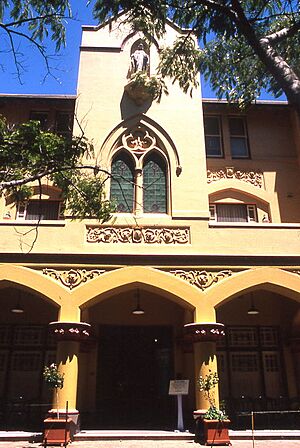
In 1866, Father Julian Tenison-Woods asked Mary and her sisters, Annie and Lexie, to open a Catholic school in Penola. They started teaching over 50 children in a renovated stable. Mary decided to dedicate her life to God and began wearing black clothes.
On 21 November 1866, other women joined Mary and her sisters. Mary took the religious name "Sister Mary of the Cross." She and Lexie started wearing simple religious clothes. This small group called themselves the Sisters of St Joseph of the Sacred Heart. They moved to Grote Street, Adelaide and opened a new school.
Father Woods and Mary created a "rule of life" for the sisters. It focused on living simply, trusting in God, not owning personal things, and being ready to go wherever they were needed. Bishop Sheil approved this rule. By the end of 1867, ten more women had joined the Josephites. They wore plain brown habits and were sometimes called the "Brown Joeys."
Growing the Sisters of St Joseph
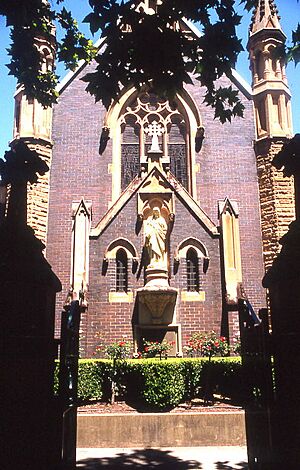
The Sisters of St Joseph wanted to educate all poor children, especially in country areas. They opened a school in Yankalilla, South Australia, in 1867. By 1869, over 70 Josephite sisters were teaching in 21 schools. They also helped with an orphanage, neglected children, and homes for the elderly and sick. The sisters were ready to live simply, like the farmers, railway workers, and miners in isolated areas.
In 1869, Mary and some sisters went to Queensland to start the order there. They were based at Kangaroo Point in Brisbane. By 1871, 130 sisters were working in over 40 schools and charities across South Australia and Queensland.
Mary MacKillop had disagreements with the Roman Catholic Bishop of Brisbane, James Quinn. They disagreed about who should control the schools. Mary believed the sisters should control them, but Bishop Quinn thought the diocese should. In 1879, Bishop Quinn told the sisters to leave his diocese. Mary and her sisters left Queensland by mid-1880. Later, in 1882, they were able to return to Queensland and opened new schools.
The Sisters of St Joseph also started foundations in many towns in New South Wales, including Tenterfield (1880), Inverell (1880), and Narrabri (1882).
A Difficult Time: Excommunication
Bishop Sheil, the bishop in Adelaide, was often away or unwell. This caused problems among the clergy. Father Charles Horan convinced Bishop Sheil that the Josephites' rules should be changed. On 22 September 1871, Bishop Sheil excommunicated Mary MacKillop. This meant she was forbidden from receiving sacraments or having contact with anyone in the church. He said it was because she was disobedient.
Even though the Josephites were not completely stopped, many of their schools closed. Mary was given free houses by a Jewish merchant, Emanuel Solomon, and was also helped by Jesuit priests.
Before he died, Bishop Sheil asked Father Horan to lift Mary's excommunication. On 21 February 1872, Mary was forgiven. A church investigation later cleared her completely.
Travel to Rome
After getting a new Mother House in Kensington in 1872, Mary prepared to go to Rome. She wanted the "Rule of Life" for the Sisters of St Joseph to be officially approved by the Pope.
Mary traveled to Rome in 1873. Pope Pius IX encouraged her work. The church leaders in Rome made some changes to the Josephites' rule, especially about how they lived in poverty. They said the order would get final approval after a trial period. These changes caused a disagreement between Mary and Father Woods. He felt the new rules didn't keep the ideal of poverty. They later made up before Father Woods died in 1889.
While in Europe, Mary also visited many places to learn about different ways of teaching.
During this time, the Josephites expanded into New South Wales and New Zealand. Mary moved to Sydney in 1883.
Returning to Australia
Mary returned to Australia in January 1875. She brought approval from Rome for her sisters and their work. She also brought school materials, books, several priests, and 15 new Josephite sisters from Ireland. Even with this success, she still faced opposition from some priests and bishops. This continued even after she was unanimously elected as the superior general in March 1875.
The Josephites were different from other Catholic groups in two main ways. First, the sisters lived in the community, not just in convents. Second, their rules said that a superior general chosen from within the group would lead them, not a bishop. This was unusual then. They also refused government funding, did not teach music, and would not educate rich girls. Because of these differences, the sisters had to leave Bathurst in 1876 and Queensland by 1880.
Despite these challenges, the group grew. By 1877, they ran over 40 schools in and around Adelaide, and many others in Queensland and New South Wales. With help from non-Catholics, Mary and the Josephites continued their good work, including visiting prisoners.
Life became a bit easier for Mary and her sisters after Roger Vaughan became Archbishop of Sydney in 1877.
In 1885, Pope Leo XIII officially approved the Josephites as a religious group, with their main office in Sydney.
On 31 May 1886, Mary's mother, Flora MacKillop, died in a shipwreck while traveling to visit Mary.
Pope Leo XIII gave the final approval to the Sisters of Saint Joseph of the Sacred Heart in 1888.
The Josephite sisters were very successful, even though they still relied on donations. They had schools in many country towns in South Australia. Mary continued her work in Sydney and supported the sisters in South Australia. In 1883, the order started in Temuka in New Zealand, where Mary stayed for over a year. In 1889, they also started in Victoria.
Mary helped Mother Bernard manage the Sisters of St Joseph. She wrote many letters of support and advice. By 1896, Mary was back in South Australia, visiting sisters. That same year, she traveled to New Zealand again. While there, a school was set up in Arrowtown. A small yellow cottage, now called Mary MacKillop cottage, became a convent for the sisters.
In 1897, Mary founded a convent in Petersburg (now Peterborough).
After Mother Bernard died, Mary was again elected superior general in 1899. She held this position until her death. In her later years, her health got worse. She had rheumatism and a stroke in 1902 in Auckland, New Zealand. The stroke paralyzed her right side. She used a wheelchair for seven years but could still speak and think clearly. She learned to write with her left hand and continued writing letters. Even after her stroke, the sisters re-elected her in 1905.
Mary MacKillop's Death
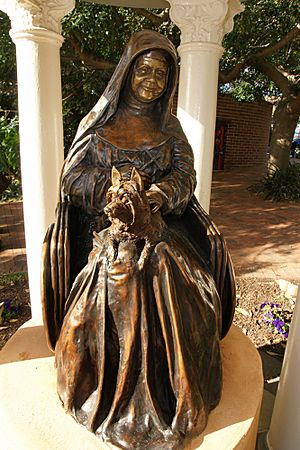
Mary MacKillop died on 8 August 1909 at the Josephite convent in North Sydney. The Archbishop of Sydney, Cardinal Moran, said: "I consider this day to have assisted at the deathbed of a saint." She was buried at the Gore Hill cemetery.
People kept taking earth from her grave. So, her remains were moved on 27 January 1914. They were placed in a vault in the new memorial chapel in Mount Street, North Sydney. This vault was a gift from Joanna Barr Smith, a lifelong friend.
Becoming a Saint and Being Remembered
In 1925, the Mother Superior of the Sisters of St Joseph, Mother Laurence, started the process for Mary to be declared a saint. After many years of investigations, Mary's "heroic virtue" was recognized in 1992. That same year, the Church accepted that Veronica Hopson, who was dying of leukemia in 1961, was cured by praying to Mary. Mary was declared "blessed" (beatified) on 19 January 1995 by Pope John Paul II.
On 19 December 2009, the Catholic Church officially recognized a second miracle. This was the complete cure of Kathleen Evans from lung and brain cancer in the 1990s. Kathleen Evans later wrote a book about this miracle. Mary's canonization (being declared a saint) was announced on 19 February 2010. It happened on 17 October 2010. This made her the first Australian saint.
How Mary MacKillop is Recognized
The Australian government protects the use of Mary MacKillop's name for commercial purposes. Only one other Australian, cricket legend Sir Donald Bradman, has similar protection. Australia Post released a stamp to celebrate her canonization.
About 8,000 Australians went to the Vatican City to see the ceremony. The Vatican Museum had an exhibition of Aboriginal art to honor the event.
Mary MacKillop is remembered in many ways in Australia. Things named after her include:
- The electoral district of MacKillop in South Australia.
- Several MacKillop colleges.
- The Mary MacKillop Rose, developed in 1985.
- She was featured on the first "Inspirational Australians" one-dollar coin in 2008.
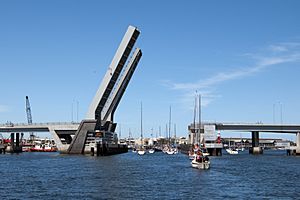
Australian composers have written sacred music to celebrate Mary. Hymns used in celebrations include A Saint for Today and Mary MacKillop, Woman of Australia.
In 2018, The University of Scranton in Pennsylvania renamed a residence hall "MacKillop Hall" after her.

Images for kids
See also
 In Spanish: Mary MacKillop para niños
In Spanish: Mary MacKillop para niños











